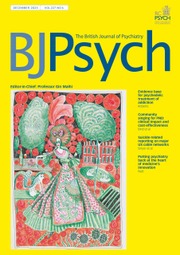Paprika is a 2006 Japanese animated film directed and co-written by Satoshi Kon, based on the novel by Yasutaka Tsutsi. The story follows a group of psychiatric researchers who have created a device, known as the DC Mini, which allows them to enter the dreams of their patients. Designed with the purpose of facilitating novel psychotherapies, the film explores the device’s unintended consequences when it is stolen by a mysterious party who use it to manipulate dream content and control others.
For psychiatrists, dreams have long been a subject of interest. Around the turn of the 20th century, in his seminal book Die Traumdeutung, Sigmund Freud described the interpretation of dreams as the ‘royal road to a knowledge of the unconscious activities of the mind’.Reference Freud1 For Freud, dreams represented an expression of patients’ inner worlds, their repressed impulses and unresolved conflicts. In particular, he argued that their function was ‘wish fulfillment’, or the expression of desires which are inaccessible or unacceptable to the conscious mind. Since then, scientists have studied the state of dreaming from various different angles, ranging from neurophysiology to thematic analysis. Despite this, the answer to the question of why we dream has yielded only theories, and the true purpose of dreaming is still unknown.
In truth, the study of dreaming is limited by the fact that the phenomenon cannot be directly observed, and participants can only self-report on their experience retrospectively. Paprika imagines a world where psychiatrists can observe and even partake in their patients’ dreams, and the therapeutic potential of a shared dreaming experience is explored. The DC Mini offers the opportunity for psychiatrists to – in the words of the film’s protagonist Dr Chiba – pursue ‘a deeper connection with our patients’. Drawn to the intrigue and mystery of the dream-world, Chiba decides to use the device outside its intended research setting, and agrees to help a detective suffering from recurrent nightmares related to an unsolved homicide case. As the film progresses, the latent content of his dreams begins to emerge, and together they uncover a slew of repressed memories and desires that are seemingly incompatible with his career as a high-ranking member of the police force. All the while, during her unauthorised use of the device, Chiba moves through the dream-world as her alter-ego, Paprika. By embodying a woman who is so far removed from her reality as an unassuming, buttoned-up clinician, it would be fair to say that Chiba is able to achieve some wish fulfilment of her own.
Although steeped in sci-fi aesthetics and futuristic technical dialogue, Paprika leans on psychoanalytic concepts. It asks philosophical questions about dreaming and ponders the ethical implications of a world in which the vulnerability of the dream-state is open to exploitation. Kon explores the phenomenology of dreaming in the way he masterfully brings to life the obscurity and uncanny nature of the dream-world. Certain foundational qualities of the film itself also seem to capture the essence of dreaming, such as its highly visual nature, the use of vivid colour and movement and its broken narrative structure. The film questions the very purpose of dreaming and its relationship with waking life, which in reality is still largely unknown and open to future research.
Paprika was Kon’s final film before he died of pancreatic cancer at the age of 46. His films, also including Perfect Blue (1997) and Millennium Actress (2001), take the audience headfirst into the surreal and bizarre, bending the boundaries between illusion and reality, and always with a psychological flavour.
Declaration of interest
None.



eLetters
No eLetters have been published for this article.